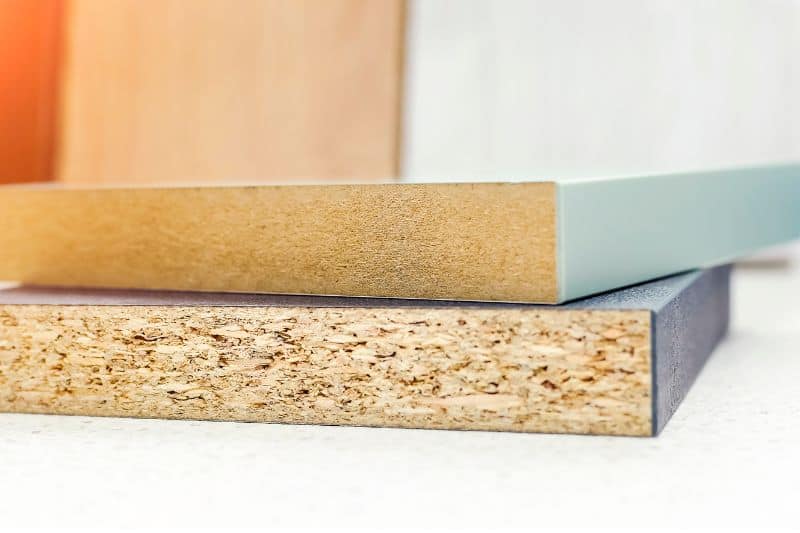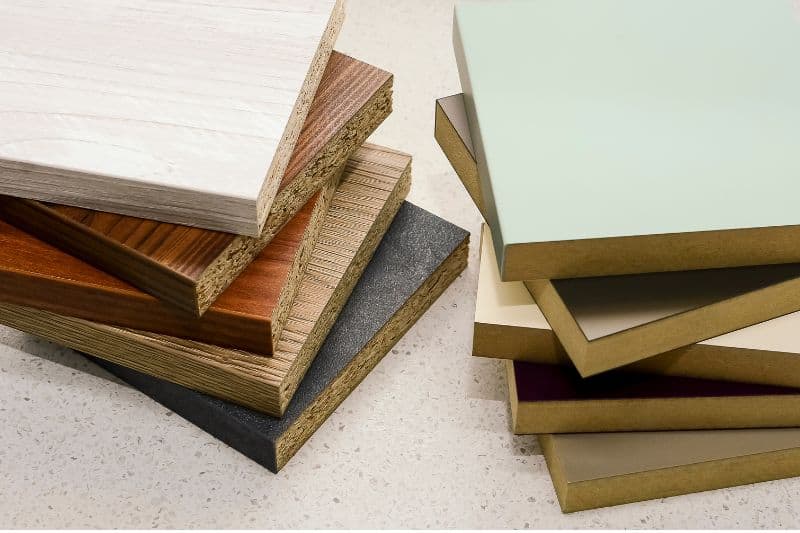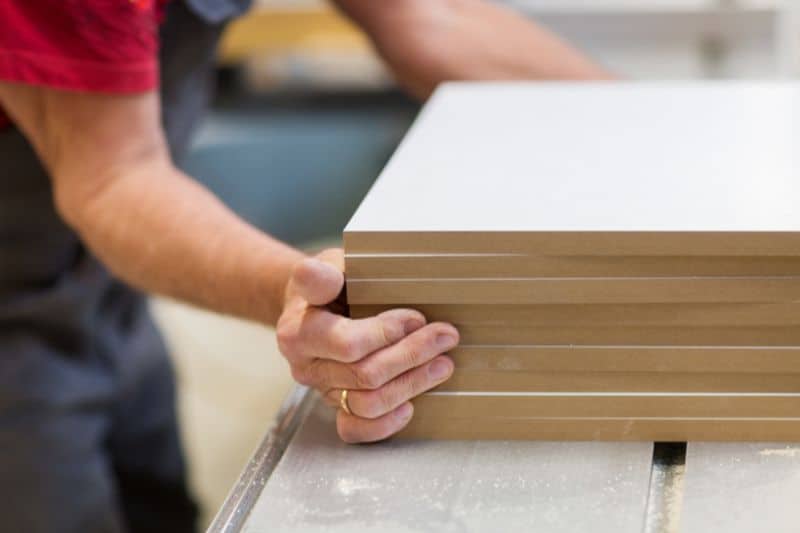Wood is an indispensable building material. We need it in every industry — domestic, commercial, pharmaceutical, among many others. There are different types of wood too, and each serves different purposes, with some boasting multiple uses.
Now, among the many varieties of wood is MDF. It’s an abbreviation for medium-density fiberboard, and it’s made by combining hardwood or softwood, resin binder, and wax.
MDF can serve in a wide range of constructions, whether domestic or otherwise. It is durable and cheaper, so you end up spending a lot less than you would on some other types of wood.
But again, nothing lasts forever, and you’re going to have to dispose of your MDF items some day.
The major concern is how you go about that. Is MDF recyclable, and how easy is it to find a recycling center that accepts it?
Please, read on to find out. Let’s go!
Can You Recycle MDF?
Yes, MDF is recyclable, but you can’t do it at just any recycling center. Curbside recycling centers don’t accept MDF, and that’s because despite being a combination of hardwood or softwood, this material also contains formaldehyde and paraffin wax, and these make it a difficult material to recycle.
Before we delve any deeper, we believe you need to understand what MDF is made from. And well, it’s a type of wood that uses hardwood or softwood as the primary constituents.
Manufacturers begin by slicing hardwood or softwood into thin veneers. They then use a formaldehyde resin glue, water and paraffin wax to secure the veneers together. That’s why thin sheets of wood can end up providing such durability and utility in diverse areas.
But then, bringing in paraffin wax and resin glue makes it difficult to recycle. That’s why it needs special attention.
You can take it to your community’s center for recycling household waste. The majority of communities should have that, but if yours doesn’t, there’s no need to fret.
You can find a company that recycles construction materials; they’ll do the needful. An internet search is enough to point you in the right direction. If the MDF item you want to recycle is quite large, you can pay for pick-up services. On the other hand, you can take it down yourself if it’s easily moveable.
The recycling process for MDF is different from other wood materials. The major reason you can’t recycle MDF at a curbside recycling center is how the process is carried out. It’s not like other household materials that a typical recycling machine can handle.
Recycling MDF is tricky because of the elements it features and the fact that it’s usually made from recycled wood.
Now, here’s how MDF is recycled. The first step is to shred it. Then, it’ll be soaked in a liquid medium for a long time. Then, it’ll be exposed to a temperature of 90°C.
The process hydrolyzes the formaldehyde and wax in the wood and makes it possible for us to derive the wood fibers without the formerly present binders.

Can I Put MDF in the Recycle Bin?
Although MDF is made from wood and can be household waste, you can’t put it in the recycle bin. It’s made from recycled wood, formaldehyde, and paraffin wax, and all these materials combined pose difficulties for the average recycling center.
We can all agree that curbside recycling has made our lives much easier. It’s as simple as walking out of your home with a ton of household waste and disposing of them in the bin your community provides.
You can recycle a range of household waste there, and you’ll feel better about contributing to saving the environment. However, it’s not all your waste that you can recycle, and for some like MDF, it’s a matter of chance!
So, you’re going to have to take it a step further by inquiring at the household waste disposal center in your community if they accept MDF items. If they do, then jackpot! You’ll have no difficulty recycling your unwanted items.
On the other hand, there’s a slight possibility that they don’t. Then, you can make inquiries about the companies that recycle construction waste close to you. They’ll happily take on the MDF items, and they’re entirely capable of recycling them for you.
Is MDF Made From Recycled Wood?
Yes, MDF is usually made from recycled wood. It can be hardwood or softwood that goes through a defibrator and high temperatures. Using recycled wood means we don’t have to fell trees to get wood for furniture, flooring, cabinets, among many other things.
You see, deforestation is fast becoming a cause of worry globally. Trees are felled without remorse or the thought of planting replacements. Of course, trees are renewable natural resources, but we aren’t managing them well, so we may run out of them someday.
Thankfully, MDF uses recycled wood as a way to help cut back on our consumption of trees. And yes, you may think that because it’s made from such materials, it can’t compare to other wood items. However, that’s a misconception.
MDF can serve you for a long time, as long as you maintain it well. So, even though MDF is made from recycled wood in the form of sawdust, it has been designed to serve you as a better and cheaper substitute.
In fact, that’s why its one of the most common materials. Chances are you own an MDF item, and you aren’t aware. It’s common for making furniture, cabinets, and other items that’ll be indoors and away from water because it’s susceptible to water damage. But aside from that, MDF is a cheaper alternative.
Is MDF Biodegradable?
With biodegradation, the environment doesn’t have to deal with many materials because they’ll eventually dissipate. They will break down and meld with the environment.
Let’s delve further into what biodegradation is and what it entails. You see, any material that nature can break down easily is biodegradable. Aside from that, these materials will dissipate quickly, as opposed to non-biodegradable materials that require decades to thousands of years to decompose fully.
As long as microbes, oxygen, moisture and the right weather conditions are present, a biodegradable material will decompose. Most times, materials made from natural resources are biodegradable. For example, MDF is made from wood, which is made from trees.
So, is it biodegradable? Well, the short answer is yes. Now, while some may wonder if the presence of paraffin wax and formaldehyde will make biodegradation possible. In actuality, these components aren’t a problem. They aren’t present in large quantities; they don’t make up the majority of MDF.
Instead, the sawdust is the larger percentage of MDF, so that’s what microbes will focus on. MDF is particularly susceptible to water damage, so once you expose it to sufficient water, it’ll decompose within a short time.

Is MDF Sustainable?
Producing sustainable materials is no longer an option – it’s a must if we intend to conserve our renewable and non-renewable resources. Mismanagement can cause them to deplete.
On the other hand, producing sustainable resources is also important because of disposal concerns. When we have sustainable materials, we know we can recycle them repeatedly. As such, we worry less about where they’ll end up, like on our landfills.
In addition, the materials in question may take so long to decompose or release toxic waste into the environment during the process. So, if they’re sustainable, we postpone the process for a long time.
Now, is MDF sustainable? To answer this question, we have to consider what it’s made from. MDF is made from recycled wood or sawdust. As such, its production does not require felling new trees.
That way, we don’t have to worry about deforestation where MDF production is concerned. So, in this manner, we can say MDF is sustainable.
Another factor we need to consider is its production. Does the production of MDF require the consumption of fuel and energy in large quantities? Absolutely not!
Again, MDF is made from sawdust, which means it’s already existed before. It simply needs some additional components to get it to what it eventually becomes.
So, producing it doesn’t require long and rigorous stages that consume fuel. As such, we don’t need to worry about its production process releasing fumes that can deplete the ozone layer and pollute the atmosphere.
Now, how long can you use MDF products? This is another factor that determines sustainability. If you have furniture made from MDF, you can use it for about twenty years. Of course, if you maintain it, you could use it for longer periods. The same goes for other items that are made from MDF.
So, durability makes MDF a sustainable material.
Finally, let’s consider the method of disposing of MDF. Does it harm the environment? Of course not.
MDF is made from wood, and this type of wood isn’t waterproof. As such, introducing enough water to it will result in an accelerated decomposition. During the process, you don’t need to worry about any form of pollution. It’ll also decompose entirely, leaving no remnants in the environment.
Can You Burn MDF?
Yes, you can burn MDF. However, we don’t recommend that you do it at home. The fire can go out of hand, and you may have difficulty controlling it. As such, if you need to dispose of your MDF items, you can take them to your household waste recycling center. Alternatively, you could find a company that recycles wood items.
In addition, burning MDF is terrible for the environment. Burning anything always affects the environment, no matter how subtle.
Regarding MDF, burning it is similar to burning fuel. It releases some toxins that make their way to the atmosphere. From there, you can be assured these toxic gases will also find their way to the ozone layer, and that’s been steadily contributing to its depletion.
While you can burn MDF, it’s best to avoid it. Even commercial wood plants don’t have permission to burn wood because of its negative impacts on the environment.
So, we recommend finding a recycling center if you want to throw away any MDF item you own. It’s a safer and better alternative for you and the environment.
Conclusion
MDF is fast becoming an alternative because it takes away the need to fell trees. That way, we’re conserving our supply. But, let’s face it, even though trees are renewable natural resources, most of them require years to reach maturity.
If we keep cutting them down at a constant rate, we may reach a point where we’ll have to wait for years before we can fell trees again. So, to prevent that, we have to consider other sustainable options like MDF, which is also recyclable.






